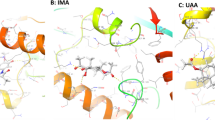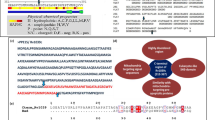Abstract
The proline-rich inhibitor of 31 kDa (PI31) is highly conserved through metazoan evolution, and its activity in the proteasome inhibition is well-established although the precise mechanism of inhibition is unclear. The coding DNA sequence of Schistosoma mansoni PI31 (SmPI31) was cloned, and the recombinant protein was expressed in bacterial system. The correct amino acid sequence was confirmed by mass spectrometry and circular dichroism suggests that SmPI31 contains both α-helix and non-structured regions. Inhibition assays, using the Suc-Leu-Leu-Val-Tyr-4-MCA substrate for proteasome degradation, showed that the S. mansoni proteasome may be regulated by the inhibitory activity of SmPI31. A gene expression assay using qRT-PCR at various stages during the S. mansoni life cycle has shown that SmPI31 transcripts are expressed in all studied stages, suggesting that PI31 plays an important role during the developmental processes of the parasite. In this study first evidence is presented that PI31 has a conserved structure and plays a role as proteasome inhibitor in adult worms and it is expressed through life cycle.





Similar content being viewed by others
Abbreviations
- Suc-Leu-Leu-Val-Tyr-MCA:
-
Succinyl-Leucine-Leucine-Valine-Tyrosine-4-methyl-coumaryl-7-amide
- UVCD:
-
Ultra-violet circular dichroism
- IPTG:
-
Isopropyl-β-d-thiogalactopyranoside
References
Ashton PD, Harrop R, Shah B, Wilson RA (2001) The schistosome egg: development and secretions. Parasitology 122:329–338
Basch PF (1981) Cultivation of Schistosoma mansoni in vitro. I. Establishment of cultures from cercariae and development until pairing. J Parasitol 67:179–185
Castro-Borges W, Cartwright J, Ashton PD et al (2007) The 20S proteasome of Schistosoma mansoni: a proteomic analysis. Proteomics 7:1065–1075
Chitsulo L, Loverde P, Engels D (2004) Schistosomiasis. Nat Rev Microbiol 2:12–13
Chu-Ping M, Slaughter CA, DeMartino GN (1992) Purification and characterization of a protein inhibitor of the 20S proteasome (macropain). Biochim Biophys Acta 1119:303–311
Crabtree JE, Wilson RA (1980) Schistosoma mansoni: a scanning electron microscope study of the developing schistosomulum. Parasitology 81:553–564
Dillon GP, Feltwell T, Skelton JP et al (2006) Microarray analysis identifies genes preferentially expressed in the lung schistosomulum of Schistosoma mansoni. Int J Parasitol 36:1–8
Fantappie MR, Osman A, Ericsson C, Niles EG, LoVerde PT (2003) Cloning of Schistosoma mansoni Seven in Absentia (SmSINA)(+) homologue cDNA, a gene involved in ubiquitination of SmRXR1 and SmRXR2. Mol Biochem Parasitol 131:45–54
Guerra-Sa R, Castro-Borges W, Evangelista EA, Kettelhut IC, Rodrigues V (2005) Schistosoma mansoni: functional proteasomes are required for development in the vertebrate host. Exp Parasitol 109:228–236
Harrop R, Wilson RA (1993) Protein synthesis and release by cultured schistosomula of Schistosoma mansoni. Parasitology 107(Pt 3):265–274
Hill CP, Masters EI, Whitby FG (2002) The 11S regulators of 20S proteasome activity. Curr Top Microbiol Immunol 268:73–89
Jones DT, Taylor WR, Thornton JM (1992) The rapid generation of mutation data matrices from protein sequences. Comput Appl Biosci 8:275–282
Laemmli UK (1970) Cleavage of structural proteins during the assembly of the head of bacteriophage T4. Nature 227:680–685
Lawson JR, Wilson RA (1980) Metabolic changes associated with the migration of the schistosomulum of Schistosoma mansoni in the mammal host. Parasitology 81:325–336
Livak KJ, Schmittgen TD (2001) Analysis of relative gene expression data using real-time quantitative PCR and the 2(-Delta Delta C(T)) Method. Methods 25:402–408
McCutchen-Maloney SL, Matsuda K, Shimbara N et al (2000) cDNA cloning, expression, and functional characterization of PI31, a proline-rich inhibitor of the proteasome. J Biol Chem 275:18557–18565
Rechsteiner M, Hill CP (2005) Mobilizing the proteolytic machine: cell biological roles of proteasome activators and inhibitors. Trends Cell Biol 15:27–33
Saitou N, Nei M (1987) The neighbor-joining method: a new method for reconstructing phylogenetic trees. Mol Biol Evol 4:406–425
Santos DN, Aguiar PH, Lobo FP et al (2007) Schistosoma mansoni: heterologous complementation of a yeast null mutant by SmRbx, a protein similar to a RING box protein involved in ubiquitination. Exp Parasitol 116:440–449
Smithers SR, Terry RJ (1965) The infection of laboratory hosts with cercariae of Schistosoma mansoni and the recovery of the adult worms. Parasitology 55:695–700
Takezaki N, Rzhetsky A, Nei M (1995) Phylogenetic test of the molecular clock and linearized trees. Mol Biol Evol 12:823–833
Tukey JW (1953) The problem of multiple comparisons. Dittoed manuscript of 386 pages, New Jersey: Department of Statistics, Princeton University
Ustrell V, Hoffman L, Pratt G, Rechsteiner M (2002) PA200, a nuclear proteasome activator involved in DNA repair. EMBO J 21:3516–3525
Wolf DH, Hilt W (2004) The proteasome: a proteolytic nanomachine of cell regulation and waste disposal. Biochim Biophys Acta 1695:19–31
Zaiss DM, Standera S, Holzhutter H, Kloetzel P, Sijts AJ (1999) The proteasome inhibitor PI31 competes with PA28 for binding to 20S proteasomes. FEBS Lett 457:333–338
Zaiss DM, Standera S, Kloetzel PM, Sijts AJ (2002) PI31 is a modulator of proteasome formation and antigen processing. Proc Natl Acad Sci USA 99:14344–14349
Acknowledgments
The authors thank the Brazilian research agencies: FAPESP (Fundação de Amparo a Pesquisa do Estado de São Paulo) and CAPES (Coordenacao de Amparo ao Pessoal de Nivel Superior). We are also grateful to Elenice A. Macedo and Olinda Mara Brigato for their technical assistance.
Author information
Authors and Affiliations
Corresponding author
Rights and permissions
About this article
Cite this article
Botelho-Machado, C., Cabral, F.J., Soares, C.S. et al. Characterization and mRNA expression analysis of PI31, an endogenous proteasome inhibitor from Schistosoma mansoni . Parasitol Res 107, 1163–1171 (2010). https://doi.org/10.1007/s00436-010-1984-x
Received:
Accepted:
Published:
Issue Date:
DOI: https://doi.org/10.1007/s00436-010-1984-x




